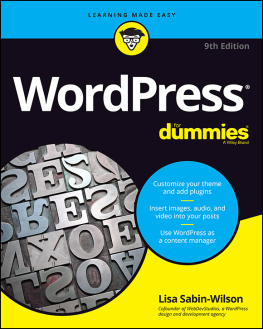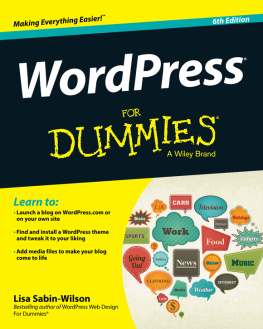A History of Stepfamilies in Early America
This book was published with the assistance of the Anniversary Endowment Fund of the University of North Carolina Press.
2014 THE UNIVERSITY OF NORTH CAROLINA PRESS
All rights reserved. Designed by Sally Scruggs. Set in Miller by codeMantra. Manufactured in the United States of America. The paper in this book meets the guidelines for permanence and durability of the Committee on Production Guidelines for Book Longevity of the Council on Library Resources.
The University of North Carolina Press has been a member of the Green Press Initiative since 2003.
Library of Congress Cataloging-in-Publication Data
Wilson, Lisa, 1957
A history of stepfamilies in early America / Lisa Wilson.
pages cm.
Includes bibliographical references and index.
ISBN 978-1-4696-1842-5 (pbk : alk. paper) ISBN 978-1-4696-1843-2 (ebook)
1. StepfamiliesUnited StatesHistory. 2. FamiliesUnited StatesHistory
3. United StatesHistoryColonial period, ca. 16001775. I. Title.
HQ535.W55 2014
306.87470973dc23
2014017086
18 17 16 15 14 5 4 3 2 1
To the memory of my mother, Constance Hall Wilson, and my grandmother, Constance Patton Hall
Contents
TWO. Stepfathers in the Law
The Case of Silas Deane and the Webb Family
Appendix
On the Methodology Used in This Book
Illustrations
Edward Savage, The Washington Family, 178996,
Attributed to William Johnston, Silas Deane, ca.1766,
Gilbert Stuart, Theodore Sedgwick Sr., ca. 1808,
William Blackstone, A Treatise on the Law of Descents in Fee-Simple,
John Holyoke, Holyoke Genealogy Chart, October 1746,
John Singleton Copley, Boy with a Squirrel (Henry Pelham), 1765,
Preface
About Cinderella... Charles Perrault, in his Tales of Mother Goose, published the story in 1697 as an adult tale designed to entertain members of the French royal court.
Likewise, in the Grimms first version of Hansel and Gretel, their mother urges their father to abandon them in the woods to save on food, while in the new and improved version, their stepmother becomes the culprit. Mothers were by definition loving, so the culture gave stepmothers the baggage of cruelty that mothers had left behind.
Acknowledgments
I am a stepchild. In fact, I have been a part of a stepfamily of one sort or another practically all of my life. My deep personal experience with stepfamilies helped bring me to this topic. This book comes as well from my experience as a historian of the family and gender in early America. My earlier work on widows in Pennsylvania and men in colonial New England helped me see the prevalence of these families in the past. In addition, through my research, I have come to realize that scholars of literature, sociology, and anthropology are the experts on stepfamilies, with very few historians tackling the topic. One of the reasons for this gap in the historical literature, I am convinced, is the difficulty of the task. These families were literally everywhere in the past, yet they are often difficult to untangle with the information available in surviving documents. I hope that others will take on the subject and answer the many questions that I have left unanswered.
I could not have completed this book without two years of grant-supported leave from my teaching obligations at Connecticut College. First, I received a Massachusetts Historical Society (MHS)/National Endowment for the Humanities long-term fellowship for the 20067 academic year. I spent a wonderful year researching in the MHSs extraordinary collections. My (fellow) fellow, Ruth Wallis Herndon, became a great colleague and friend as we worked side by side throughout those months, and she kindly read a draft of this manuscript. I also benefited from the incredible MHS staff, particularly Conrad Wright and Peter Drummey. Finally, I attended the multiple seminars and brown-bag events at the society, meeting many researchers and fellows as they came to work on the collections or to give presentations. In the 201011 academic year, an American Antiquarian Society (AAS)/National Endowment for the Humanities long-term fellowship provided me with another wonderful opportunity to work on this project. I particularly thank Laura Wasowicz, curator of childrens literature at the AAS, for suggestions that helped me find the stepchildren at the society. I spent the year living in the Goddard Daniels House, which was home to an extraordinary community of scholars. We long-termers created a writing group, reading each others work and sharing meals and more than a little wine. This scholarly paradise was and is cultivated by Paul Erickson, director of academic programs, who has earned my deep gratitude for providing the peace, solitude, and fun that makes the AAS a unique place to conduct research. I also thank Elizabeth Maddock Dillon, Sean Harvey, Daniel Rood, and Kyle Volk for their time and attention to my work. Kyle and I have continued reading each others work and cheering each other on, and I cannot thank him enough for sharing his extraordinary intellect and friendship.
I have presented my work at various venues, including the annual meeting of the Society for Historians of the Early American Republic in July 2012, the AAS Seminar in October 2010 and April 2011, the annual meeting of the American Historical Association in January 2002 and January 2010, the MHS Brown Bag Series in April 2007, the Boston Area Early American History Seminar in October 2006, the Heroism, Nationalism, and Human Rights Conference at the University of Connecticut in February 2006, and the Association for the Study of Connecticut History spring meeting in April 2002. I am very thankful for all the comments I received at these sessions.
Others who have read all or part of this book include Allegra di Bonaventura, Steven Bullock, Marc Forster, Katherine Hermes, Shan Holt, and Mike Zuckerman. I particularly thank Shan Holt for her ongoing friendship, intellectual and otherwise. I am grateful as always for Mike Zuckerman and his ongoing support of my work and belief in me. In addition, I thank my editor, Chuck Grench, for the calm encouragement that sustained me through multiple revisions.
Finally, I thank a great stepfather and husband, Dave Kanen, and my son, Alex Waciega, for their constant love and support.
A History of Stepfamilies in Early America
Introduction
Stepfamilies founded our nation. George Washington, the Father of Our Country, was a stepfather. When he married a young widow, Martha (Dandridge) Custis, in 1759, he took on her two small children, Jackie, six, and Patsy, four. When seventeen-year-old Patsy lay gravely ill with tuberculosis, her stepfather prayed at her bedside for her recovery. Jackie, at times a challenging teenager, stood at his stepfathers side when the British surrendered at Yorktown, though he died soon thereafter. Washington then offered to raise Jackies two youngest children.
The only portrait of the first, first family, titled The Washington Family, appears to depict a first-marriage family with children, and yet the Washington family was another kind of traditional American family altogether, a stepfamily. Edward Savage painted a large canvas of the domestic scene between 1789 and 1796. Washington displayed a print of the image in his dining room at Mount Vernon. Numerous companies made copies of this popular painting for sale. The children are George Washingtons step-grandchildren: George Washy Washington Parke Custis, and Eleanor Nelly Parke Custis. Washington sits relaxed with his arm resting on his step-grandsons shoulder. His step-granddaughter stands by her grandmother with William Lee, one of Washingtons slaves, in the background. Washington proudly sits in his military uniform looking over the plans of the new city of Washington while a view of Mount Vernon serves as a backdrop. He is the quintessential slave master, plantation owner, military leader, husband, and step-grandfather. In other words, he appears as the patriarch of a family he has not sired. The first, first family was a stepfather family.







